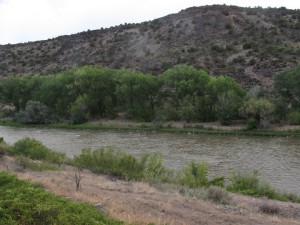**This article is not a substitute for the advice of an attorney.**
Today we turn to our third and final post in the Texas Water Wars series. Here are links to the first two posts in this series: United States v. Mexico and Texas v. Oklahoma.
Background
In 1938, Texas, New Mexico, and Colorado entered into the Rio Grande Compact (“the Compact”) to allocate water from the Rio Grande between the three states. The Compact requires that New Mexico deliver water into the Elephant Butte Reservoir. At that point, the United States Bureau of Reclamation allocates the water between beneficiaries in Texas and New Mexico. (An additional lawsuit is pending in New Mexico federal court between New Mexico and the Bureau of Reclamation because the percentage of water allocated between the two states was modified in 2008 from 57% to New Mexico and 43% to Texas to the current percentages of 38% to New Mexico and 62% to Texas.) The allocated water is for the benefit of two beneficiaries: the Elephant Butte Irrigation District (New Mexico) and the El Paso County Water Improvement District No. 1 (Texas). [Read full Compact text here.]
The Lawsuit
In February 2013, Texas filed suit against New Mexico and Colorado in the United States Supreme Court in a battle concerning the Compact. Although Texas sued both New Mexico and Colorado, it appears that Colorado was named only because they are party to the treaty at issue. All of Texas’ claims are based upon alleged wrongful conduct by and in New Mexico.
It may seem strange that the lawsuit was actually filed in (as opposed to being appealed to) the United States Supreme Court. The reason for this is that the United States Constitution provides original jurisdiction to the Supreme Court for all disputes between states. In this instance, a state must file a motion seeking permission to file the complaint and a brief explaining why the Court should hear the case. [See Texas’ Motion for Leave to File Complaint here.]
So now that the motion has been filed, the Court will decide whether to hear the case. In making that decision, the Court considers three factors: (1) whether the dispute is truly between states (as opposed to disputes between state agencies or private claims); (2) the seriousness of the dispute–specifically looking at whether this type of conflict would lead to war between sovereign nations; and (3) whether an alternative forum is available to decide the dispute.
If it choses to hear the case, it will likely assign the case to a Special Master who will determine any factual issues in the case. After the Special Master has resolved factual disputes, the Court would then take up the case and make decisions on the legal issues.
The Parties’ Arguments
Texas claims that New Mexico is illegally depleting the Rio Grande’s flow before it reaches the New Mexico/Texas state line. Specifically, Texas claims that New Mexico allows impermissible diversion of surface water from the river and that increased groundwater pumping also depletes the river by causing the surface water to leave the river to recharge connected underground aquifers. As to the groundwater pumping, Texas points to wells–approximately 2,500 of these wells have been drilled below the Reservoir since the Compact was signed– and claims that these wells are depleting the amount of water coming to Texas pursuant to the Compact. Although Texas does not point to a specific term of the Compact that was violated and does not dispute that New Mexico is delivering the correct amount of water into the Elephant Butte Reservoir, it claims that the “purpose and intent” of the Compact is violated when New Mexico allows water to be diverted prior to delivery into Texas.
In response, New Mexico claims that its only obligation under the Compact is to deliver a certain amount of water into the Elephant Butte Reservoir. The Compact does not require any specific amount of water be delivered to the Texas/New Mexico state line. New Mexico claims that what happens between the Reservoir and the Texas state line is governed by New Mexico law and not by the Compact. New Mexico claims that the wells drilled below the Reservoir are proper as they were drilled based upon water rights that were granted under New Mexico law. [See New Mexico’s Response Brief here.]
Colorado has argued that the Court should not hear the case because Texas’ complaints are not tied to the Compact and, as New Mexico argues, the Compact does not apply to the waters south of Elephant Butte. [See Colorado’s Response Brief here.]
Texas’ lawsuit requests that the court (1) hear the case; (2) enjoin New Mexico’s diversions and depletions that take any portion of Texas’ water; (3) order New Mexico to pay for the water that it has taken through groundwater pumping and surface diversions; and (4) specifically allocate Texas’ portion of water to which it is entitled under the Compact.
Current Status
The case is currently pending in the Supreme Court, which is on its summer recess. The Court will reconvene in a couple of weeks to begin its October Term. There are, however, a couple of interesting updates that may impact the case.
* In April, the Supreme Court sought a brief from the Solicitor General on behalf of the United States to determine the federal government’s position on the case. Statistics show that the Court is far more likely to take up a case when it the Solicitor General is of the opinion it should be heard. No brief has been filed to date.
* The Texas budget for FY 2014 shows that Texas has allocated $5 million for litigation expenses related to the lawsuit. [Read article here.]
* In an illustration of the tensions over this issue, a spokesman for New Mexico Governor, Susana Martinez, has said that New Mexico “will not cede one inch of New Mexico water to Texas.” [Read article here.]
* A recent study found that New Mexico’s river flows will continue to decrease due to increased temperatures, thus making it more difficult for New Mexico to comply with its treaty and compact obligations. [Read article here.]













